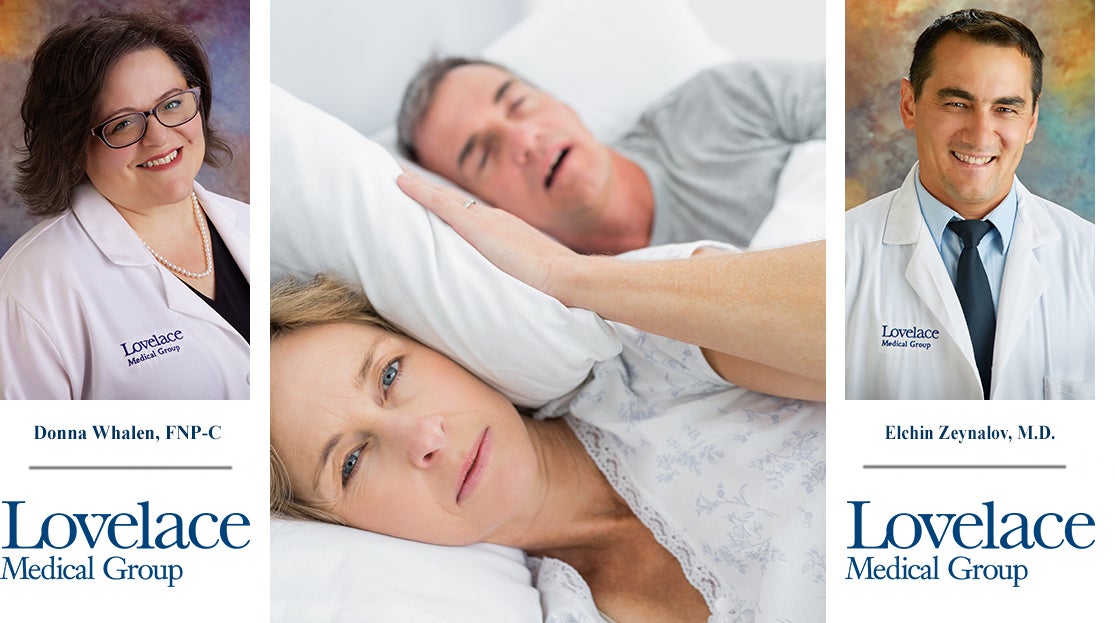
It was during a hunting trip with friends when Albuquerque resident Jeffrey Jesionowski, 69, realized that he may have a snoring problem.
“I was in Illinois with two buddies hunting white-tail deer for five days,” Jeffrey said. “We stayed overnight in a hunting camp and shared a room with bunk beds for all of us. When I woke up the next morning, I looked around and saw that my buddies were gone. I found one sleeping on the bathroom floor while the other was asleep on the living room couch.
“When they woke up, they said I snored like a freight train and they couldn’t deal with it. It embarrassed me, so for the rest of the trip, I slept on the couch and let them have the bedroom. It also helped me realize that my wife must have been dealing with my snoring for many years.”
Fortunately for Jeffrey, one of his hunting buddies is a doctor at Lovelace Medical Center and told him about the Lovelace Sleep Center. When they returned to Albuquerque, Jeffrey made an appointment for a sleep study to learn more about potential sleep issues.
Sleep study
After completing the sleep study, the results showed that Jeffrey had moderate sleep apnea with approximately 30 breathing incidents per hour – periods when he stopped breathing.
Sleep apnea is a serious sleeping disorder that has many serious side effects, such as difficulty concentrating during the day, episodes of depression or irritability or increasing one’s likelihood of developing high blood pressure, Type 2 diabetes and heart and liver problems.
“I met with Dr. Elchin Zeynalov, at the Lovelace Sleep Center. He recommended that I use a CPAP machine,” Jeffrey said.
When using a CPAP (Continuous Positive Airway Pressure) machine, the patient wears a mask over their nose and mouth while they sleep. The mask is connected by a hose to the CPAP machine, which pumps air at a mild pressure to keep their breathing airway open while sleeping.
“I used CPAP for a week and couldn’t stand it,” Jeffrey explained. “More importantly, my wife couldn’t stand it, so I asked him for an alternative. He recommended a mouthpiece that pushes the jaw forward, thereby opening the air passage. I had the appliance made and used it for about six months. By then, I felt as if my teeth were shifting. My mouth hurt and my jaw was sore. I needed something better, something that would solve both my snoring and breathing problems.”
InspireTM – Sleep apnea innovation
One night, Jeffrey was at home watching TV and saw a commercial for the Inspire™ device. He researched the company website and found excellent reviews from patients. Through the website, he connected with a local provider who reviewed the results of the first sleep study and examined Jeffrey’s throat.
In order for his health insurance to cover the cost of Inspire, Jeffrey had an endoscopy to get a clear view of his throat and airways. After that was completed, he needed an updated sleep study.
“The new sleep study showed that I was having 68 breathing incidents per hour, more than twice as many in the first study,” Jeffrey exclaimed. “That large number and the fact that I actually stopped breathing for nearly 30 seconds really got my attention!”
Jeffrey scheduled the appointment at Lovelace Medical Center to get the Inspire device installed.
“They implanted a device, about the size of a round battery, in the right side of my chest,” Jeffrey described. “They also put a device under my tongue and ran a wire to connect the two. The entire procedure took just a little more than an hour. I went in at 8 a.m. and was at home by noon.”
Thirty days later, after the incisions had fully healed, Jeffrey went into Lovelace Medical Group – Sleep Medicine in Rio Rancho. There he met Donna Whalen, a certified family nurse practitioner with the Lovelace Sleep Center, and Jonathan Stone, the local representative for Inspire.
“Jonathan demonstrated how to use the remote monitor to turn on the device and described what I should expect to feel,” Jeffrey said. “I started with a low level of stimulation, but saw very little improvement, so I increased the level of stimulation and it started to make an impact. In three months, I have progressed to level 16 and that seems to work best for me.”
When the Inspire patient is ready to go to sleep, he holds the remote monitor, which is no bigger than a cell phone, over his chest. After pressing the button, the implanted device turns on and begins to track the patient’s breathing patterns. Whenever he takes a deep breath, the device sends an electrical impulse to the tongue and causes it to move. This keeps the airway to the lungs open so the patient is able to sleep longer and deeper.
Jeffrey said that even though he feels the electrical impulse when it happens, he has gotten used to it. “It’s not painful and I hardly notice anymore.”
The Inspire device travels easily and connects via Bluetooth to an app to track hours slept, the number of times the implant was engaged and other data. This information can then be readily shared with a healthcare provider.
Importantly, Jeffrey’s wife has noticed a huge reduction in his snoring at night.
“She says my breathing is normal all night, with no gasping for air. My snoring has also decreased by 90% in the seven months I have been using Inspire. I hope that this device will give me better, restful sleep.”
Jeffrey has high praise for the staff at the Lovelace Sleep Center. “Cory was the tech on both of my visits and did a great job. I would absolutely recommend the Lovelace Sleep Center to everyone.”
While Jeffrey cautions that this device may not be for everyone, he adds that you won’t know until you give it a try.
“It certainly has improved my sleep and has changed my life – and my wife’s!”
For more information about Inspire and the Lovelace Sleep Center, visit our website.
If you want to take the STOP-BANG Sleep Questionnaire and keep a record of your answers, download and print the Questionnaire.
You may also want to see where you land on the Epworth Sleepiness Scale (ESS), so download and print the ESS.




